19 Early Islamic Art and Architecture
Islamic art encompasses visual arts produced from the seventh century onwards by culturally Islamic populations.
Learning Objectives
- Identify the influences and the specific attributes of Islamic art.
Key Points
- Islamic art is not art of a specific religion, time, place, or of a single medium. Instead it spans some 1400 years, covers many lands and populations, and includes a range of artistic fields including architecture, calligraphy, painting, glass, ceramics, and textiles, among others.
- Islamic religious art differs from Christian religious art in that it is non- figural because many Muslims believe that the depiction of the human form is idolatry and thereby a sin against God, forbidden in the Qur’an. Calligraphy and architectural elements are given important religious significance in Islamic art.
- Islamic art developed from many sources: Roman, early Christian art, and Byzantine styles; Sassanian art of pre-Islamic Persia; Central Asian styles brought by various nomadic incursions, and Chinese influences appear on Islamic painting, pottery, and textiles.
Key Terms
- Qu’ran: The central religious text of Islam, which Muslims believe to be the verbatim word of God (Arabic: Allah). It is widely regarded as the finest piece of literature in the Arabic language.
- arabesque: A repetitive, stylized pattern based on a geometrical floral or vegetal design.
- idolatry: The worship of idols.
- monotheistic: Believing in a single god, deity, spirit, etc., especially for an organized religion, faith, or creed.
Islam
Islam is a monotheistic and Abrahamic religion articulated by the Qur’an, a book considered by its adherents to be the verbatim word of God (Allah) and the teachings of Muhammad, who is considered to be the last prophet of God. An adherent of Islam is called a Muslim.
Most Muslims are of two denominations: Sunni (75–90%), or Shia (10–20%). Its essential religious concepts and practices include the five pillars of Islam, which are basic concepts and obligatory acts of worship, and the following of Islamic law, which touches on every aspect of life and society. The five pillars are:
- Shahadah (belief or confession of faith)
- Salat (worship in the form of prayer)
- Sawm Ramadan (fasting during the month of Ramadan)
- Zakat (alms or charitable giving)
- Hajj (the pilgrimage to Mecca at least once in a lifetime)
Mohammad, the prophet of Islam, is said to have been born in Mecca, the holiest religious site for Muslims. He was a charismatic preacher who was ultimately driven from Mecca to Medina where he continued to preach. His home in Medina, with a walled courtyard and a porch with columns of palm trunks is said to be the model for traditional mosque architecture. Earlier structures are also sacred to the religion. The Kaaba – meaning cube, in Arabic, is a square structure in Mecca, draped in an ornamental covering. It is said to have been built by Abraham—known as Ibrahim in the Islamic tradition—and his son, Ismail, as a sanctuary. When Mohammad returned to Mecca in 629/30 CE he resanctified the Black Stone Kaaba and it has become the site of modern hajj, or pilgrimage, which every adherent of Islam tries to do once in her life.

Islamic Art
Islamic art encompasses the visual arts produced from the seventh century onward by both Muslims and non-Muslims who lived within the territory that was inhabited by, or ruled by, culturally Islamic populations. It is thus a very difficult art to define because it spans some 1400 years, covering many lands and populations. This art is also not of a specific religion, time, place, or single medium. Instead Islamic art covers a range of artistic fields including architecture, calligraphy, painting, glass, ceramics, and textiles, among others.
Islamic art is not restricted to religious art, but instead includes all of the art of the rich and varied cultures of Islamic societies. It frequently includes secular elements and elements that are forbidden by some Islamic theologians. Islamic religious art differs greatly from Christian religious art traditions.
Because figural representations are generally considered to be forbidden in Islam, the word takes on religious meaning in art as seen in the tradition of calligraphic inscriptions. Calligraphy and the decoration of manuscript Qu’rans is an important aspect of Islamic art as the word takes on religious and artistic significance.
Islamic architecture, such as mosques and palatial gardens of paradise, are also embedded with religious significance. While examples of Islamic figurative painting do exist, and may cover religious scenes, these examples are typically from secular contexts, such as the walls of palaces or illuminated books of poetry.
Other religious art, such as glass mosque lamps, Girih tiles, woodwork, and carpets usually demonstrate the same style and motifs as contemporary secular art, although they exhibit more prominent religious inscriptions.

Islamic art was influenced by Greek, Roman, early Christian, and Byzantine art styles, as well as the Sassanian art of pre-Islamic Persia. Central Asian styles were brought in with various nomadic incursions; and Chinese influences had a formative effect on Islamic painting, pottery, and textiles.
Themes of Islamic Art
There are repeating elements in Islamic art, such as the use of stylized, geometrical floral or vegetal designs in a repetition known as the arabesque. The arabesque in Islamic art is often used to symbolize the transcendent, indivisible and infinite nature of God. Some scholars believe that mistakes in repetitions may be intentionally introduced as a show of humility by artists who believe only God can produce perfection.

Typically, though not entirely, Islamic art has focused on the depiction of patterns and Arabic calligraphy, rather than human or animal figures, because it is believed by many Muslims that the depiction of the human form is idolatry and thereby a sin against God that is forbidden in the Qur’an. However, depictions of the human form and animals can be found in all eras of Islamic secular art.
Islamic Architecture
Islamic architecture encompasses a wide range of styles and the principal example is the mosque.
Learning Objectives
- Describe the development of mosques, and their different features during different periods and dynasties.
Key Points
- A specifically recognizable Islamic architectural style emerged soon after Muhammad’s time that incorporated Roman building traditions with the addition of localized adaptations of the former Sassanid and Byzantine models.
- The Islamic mosque has historically been both a place of prayer and a community meeting space. The early mosques are believed to be inspired by Muhammad’s home in Medina, which was the first mosque.
Key Terms
- mosque: A place of worship for Muslims, corresponding to a church or synagogue in other religions, often having at least one minaret. In Arabic: masjid.
- mihrab: A semicircular niche in the wall of a mosque, that indicates the qibla (direction of Mecca), and into which the imam prays.
- minaret: The tall slender tower of an Islamic mosque, from which the muezzin recites the adhan (call to prayer).
Islamic Architecture
Islamic architecture encompasses a wide range of both secular and religious styles. The principal Islamic architectural example is the mosque. A specifically recognizable Islamic architectural style emerged soon after Muhammad’s time that incorporated Roman building traditions with the addition of localized adaptations of the former Sassanid and Byzantine models.
The Dome of the Rock
One of the earliest Islamic buildings in Jerusalem, the Dome of the Rock is literally built around a rock which is considered sacred to all three monotheistic religions. In Judaism it is believed that this was the place where God created the world and the first human, Adam. Christians believe that it is where Abraham was instructed to sacrifice his son, Isaac, and Muslims believe it is the site from which Mohammad ascended to Heaven and returned in his Night Journey.
The structure was built by Umayyad Caliph Abd al-Malik and was finished in 691-92 CE. The octagonal plan of the structure is similar to a Byzantine church, the Church of the Seat of Mary, not far from where the Dome was built. Just as the Roman Christians used the example of the Roman basilicas to plan their original churches, an example to hand may have inspired this monument to Islam when a new people took charge and announced their arrival.
The exterior was redone in tilework, but the interior is all original – at least after the rebuilding of the dome in 1022-23.


Early Mosques
The Islamic mosque has historically been both a place of prayer and a community meeting space. The early mosques are believed to be inspired by Muhammad’s home in Medina, which was the first mosque.
The Great Mosque of Kairouan (in Tunisia) is one of the best preserved and most significant examples of early great mosques. Founded in 670, it contains all of the architectural features that distinguish early mosques: a minaret, a large courtyard surrounded by porticos, and a hypostyle prayer hall.

Great Mosque of Cordoba

In 748-50, the Umahhad dynasty in Damascus, Syria, was overthrown by the Abbasids and fled across the Middle East finally settling on the Iberian peninsula where they established a new dynasty. Caliph Abd al-Rahman began construction of the great mosque in about 786.1 The horseshoe-shaped arches which came to be associated with Muslim construction was actually adopted from structures already on the site created by the Visigoths, as in the Puerta del Batisterio (Door of the Baptistery – renamed after the Christian takeover) below.
The Great Mosque of Cordoba also had a mihrab in the qibla wall. The great dome above it is decorated with thousands of tesserae which came from the Byzantine Empire in Constantinople along with craftsmen to install them.
More on the mosque can be found at: Dr. Shadieh Mirmobiny, “The Great Mosque of Cordoba,” in Smarthistory, August 8, 2015, accessed June 5, 2019, https://smarthistory.org/the-great-mosque-of-cordoba/.
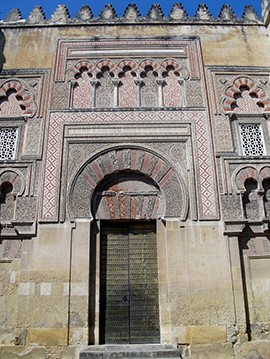
During this period Christians, Jews, and Muslims lived in relative harmony. The Christians under Queen Isabella and King Ferdinand would ultimately drive Islam out of the Spanish territory in 1492.
The minaret at the Great Mosque of Cordoba is the single tall tower in the enclosing wall. Orange trees fill the courtyard which were said to have been brought over by Caliph Abd al-Rahman to remind him of his lost home of Damascus.

Ottoman Mosques
Ottoman mosques and other architecture first emerged in the cities of Bursa and Edirne in the 14th and 15th centuries, developing from earlier Seljuk Turk architecture, with additional influences from Byzantine, Persian, and Islamic Mamluk traditions.
Sultan Mehmed II would later fuse European traditions in his rebuilding programs at Istanbul in the 19th century. Byzantine styles as seen in the Hagia Sophia served as particularly important models for Ottoman mosques, such as the mosque constructed by Sinan.
Building reached its peak in the 16th century when Ottoman architects mastered the technique of building vast inner spaces surmounted by seemingly weightless yet incredibly massive domes, and achieved perfect harmony between inner and outer spaces, as well as articulated light and shadow.
They incorporated vaults, domes, square dome plans, slender corner minarets, and columns into their mosques, which became sanctuaries of transcendently aesthetic and technical balance, as may be observed in the Blue Mosque in Istanbul, Turkey.

Architecture flourished in the Safavid Dynasty, attaining a high point with the building program of Shah Abbas in Isfahan, which included numerous gardens, palaces (such as Ali Qapu), an immense bazaar, and a large imperial mosque. Isfahan, the capital of both the Seljuk and Safavid dynasties, bears the most prominent samples of the Safavid architecture, such as the Imperial Mosque, which was constructed in the years after Shah Abbas I permanently moved the capital.
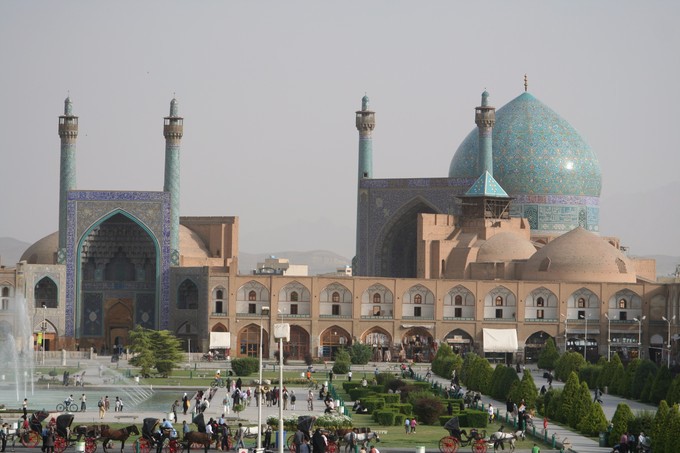
Islamic Luxury Objects
Glassmaking was the most important Islamic luxury art of the early Middle Ages.
Key Points
- Between the 8th and early 11th centuries, the emphasis in luxury glass was on effects achieved by manipulating the surface of the glass, initially by incising into the glass on a wheel, and later by cutting away the background to leave a design in relief.
- Lustre painting uses techniques similar to lustreware in pottery and dates back to the 8th century in Egypt; it became widespread in the 12th century.
Islamic Glass
For most of the Middle Ages, Islamic luxury glass was the most sophisticated in Eurasia, exported to both Europe and China. Islam took over much of the traditional glass-producing territory of Sassanian and Ancient Roman glass. Since figurative decoration played a small part in pre-Islamic glass, the change in style was not abrupt—except that the whole area initially formed a political whole, and, for example, Persian innovations were now almost immediately taken up in Egypt.
Between the 8th and early 11th centuries, the emphasis in luxury glass was on effects achieved by manipulating the surface of the glass, initially by incising into the glass on a wheel, and later by cutting away the background to leave a design in relief. The very massive Hedwig glasses, only found in Europe, but normally considered Islamic (or possibly from Muslim craftsmen in Norman Sicily), are an example of this, though they are puzzlingly late in date.
These and other glass pieces probably represented cheaper versions of vessels of carved rock crystal (clear quartz). From the 12th century, the glass industry in Persia and Mesopotamia declined, and the main production of luxury glass shifted to Egypt and Syria. Throughout this period, local centers made simpler wares, such as Hebron glass in Palestine.

Lustre painting
Lustre painting, by techniques similar to lustreware in pottery, dates back to the 8th century in Egypt, and involves the application of metallic pigments during the glass- making process. Another technique used by artisans was decoration with threads of glass of a different color, worked into the main surface, and sometimes manipulated by combing and other effects.
Gilded, painted, and enameled glass were added to the repertoire, as were shapes and motifs borrowed from other media, such as pottery and metalwork. Some of the finest work was in mosque lamps donated by a ruler or wealthy man.

Islamic Calligraphy
Calligraphic design was omnipresent in Islamic art in the Middle Ages and is seen in all types of art including architecture and the decorative arts.
Learning Objectives
- Explain the purpose and characteristics of Islamic calligraphy.
Key Points
- In a religion where figural representations are considered an act of idolatry, it is no surprise that the word and its artistic representation became an important aspect in Islamic art.
- The earliest form of Arabic calligraphy is Kufic script.
- Besides Quranic verses, other inscriptions include verses of poetry, and inscriptions recording ownership or donation.
Key Terms
- Kufic script: The earliest form of Arabic calligraphy, noted for its angular form.
- calligraphy: The art of writing letters and words with decorative strokes.
In a religion where figural representations are considered an act of idolatry, it is no surprise that the word and its artistic representation became an important aspect in Islamic art. The most important religious text in Islam is the Quran, which is believed to be the word of God. There are many examples of calligraphy and calligraphic inscriptions pertaining to verses from the Quran in Islamic arts.
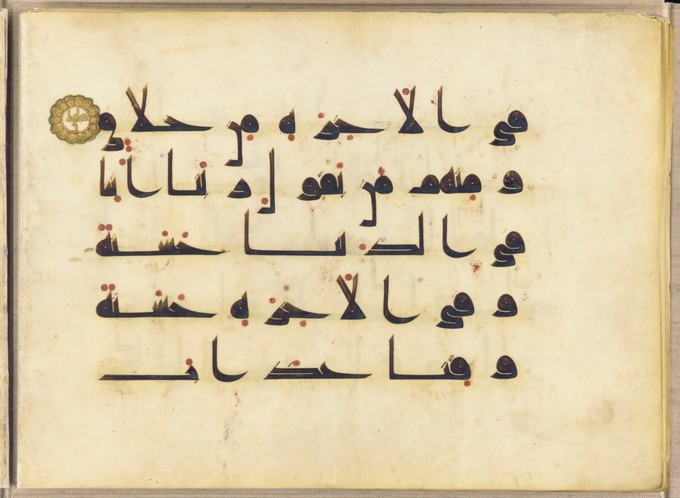
The earliest form of Arabic calligraphy is Kufic script, which is noted for its angular form. Arabic is read from right to left and only the consonants are written. The black ink in the image above from a 9th century Quran marks the consonants for the reader. The red dots that are visible on the page note the vowels.
However, calligraphic design is not limited to the book in Islamic art. Calligraphy is found in several different types of art, such as architecture. The interior of the Dome of the Rock (Jerusalem, circa 691), for example, features calligraphic inscriptions of verses from the Quran as well as from additional sources. As in Europe in the Middle Ages, religious exhortations such as Quranic verses may be included in secular objects, especially coins, tiles, and metalwork.
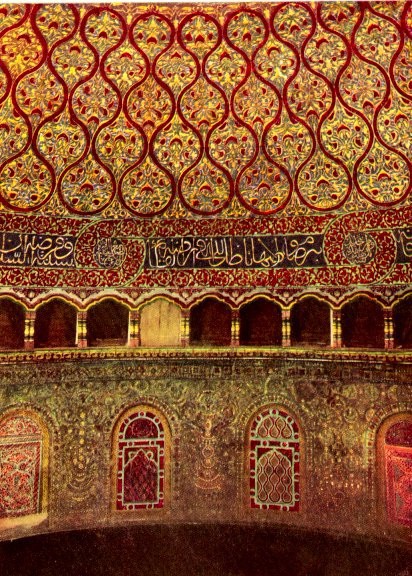
Calligraphic inscriptions were not exclusive to the Quran, but also included verses of poetry or recorded ownership or donation. Calligraphers were highly regarded in Islam, which reinforces the importance of the word and its religious and artistic significance.
Islamic Book Painting
Manuscript painting in the late medieval Islamic world reached its height in Persia, Syria, Iraq, and the Ottoman Empire.
Learning Objectives
- Discuss the origin and development of Islamic manuscript painting.
Key Points
- The art of the Persian book was born under the Ilkhanid dynasty and encouraged by the patronage of aristocrats for large illuminated manuscripts.
- Islamic manuscript painting witnessed its first golden age in the 13th century when it was influenced by the Byzantine visual vocabulary and combined with Mongol facial types from 12th-century book frontispieces.
- Under the rule of the Safavids in Iran (1501 to 1786), the art of manuscript illumination achieves new heights, in particular in the Shahnameh of Shah Tahmasp, an immense copy of Ferdowsi’s epic poem that contains more than 250 paintings.
- The medieval Islamic texts called Maqamat were some of the earliest coffee- table books and among the first Islamic art to mirror daily life.
- Masterpieces of Ottoman manuscript illustration include the two books of festivals, one from the end of the 16th century and the other from the era of Sultan Murad III.
Key Terms
- Mongols: An umbrella term for a large group of Mongolic and Turkic tribes united under the rule of Genghis Khan in the 13th century.
- illuminated manuscripts: A book in which the text is supplemented by the addition of decoration, such as decorated initials, borders (marginalia), and miniature illustrations.
- miniature: An illustration in an ancient or medieval illuminated manuscript.
Islamic Book Painting
Book painting in the late medieval Islamic world reached its height in Persia, Syria, Iraq, and the Ottoman Empire. The art form blossomed across the different regions and was inspired by a range of cultural reference points.
The evolution of book painting first began in the 13th century, when the Mongols, under the leadership of Genghis Khan, swept through the Islamic world. Upon the death of Genghis Khan, his empire was divided among his sons and dynasties formed: the Yuan in China, the Ilkhanids in Iran, and the Golden Horde in northern Iran and southern Russia.
Miniatures
The tradition of the Persian miniature (a small painting on paper) developed during this period, and it strongly influenced the Ottoman miniature of Turkey and the Mughal miniature in India. Because illuminated manuscripts were an art of the court, and not seen in public, constraints on the depiction of the human figure were much more relaxed and the human form is represented with frequency within this medium.
Influence from the Byzantine visual vocabulary (blue and gold coloring, angelic and victorious motifs, symbology of drapery) was combined with Mongol facial types seen in 12th-century book frontispieces. Chinese influences in Islamic book painting include the early adoption of the vertical format natural to a book. Motifs such as peonies, clouds, dragons, and phoenixes were adapted from China as well, and incorporated into manuscript illumination.
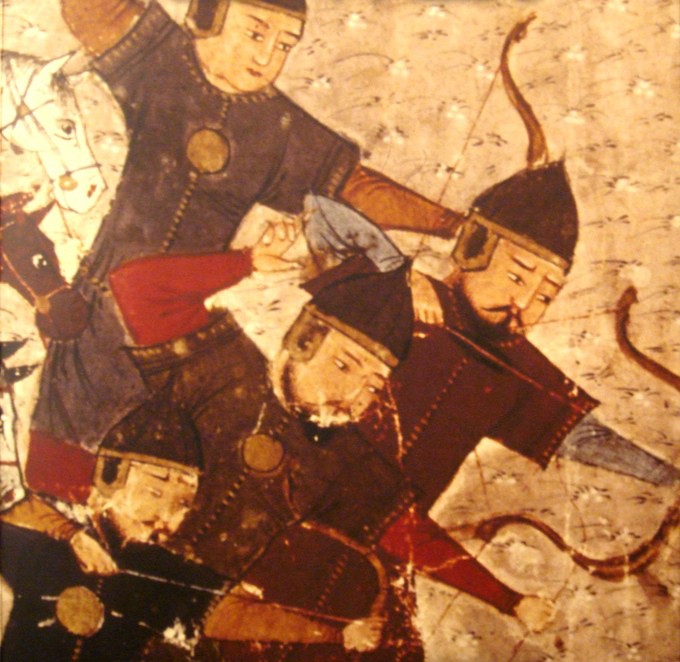
The largest commissions of illustrated books were usually classics of Persian poetry, such as the Shahnameh. Under the rule of the Safavids in Iran (1501 to 1786), the art of manuscript illumination achieved new heights. The most noteworthy example of this is the Shahnameh of Shah Tahmasp, an immense copy of Ferdowsi’s epic poem that contains more than 250 paintings.
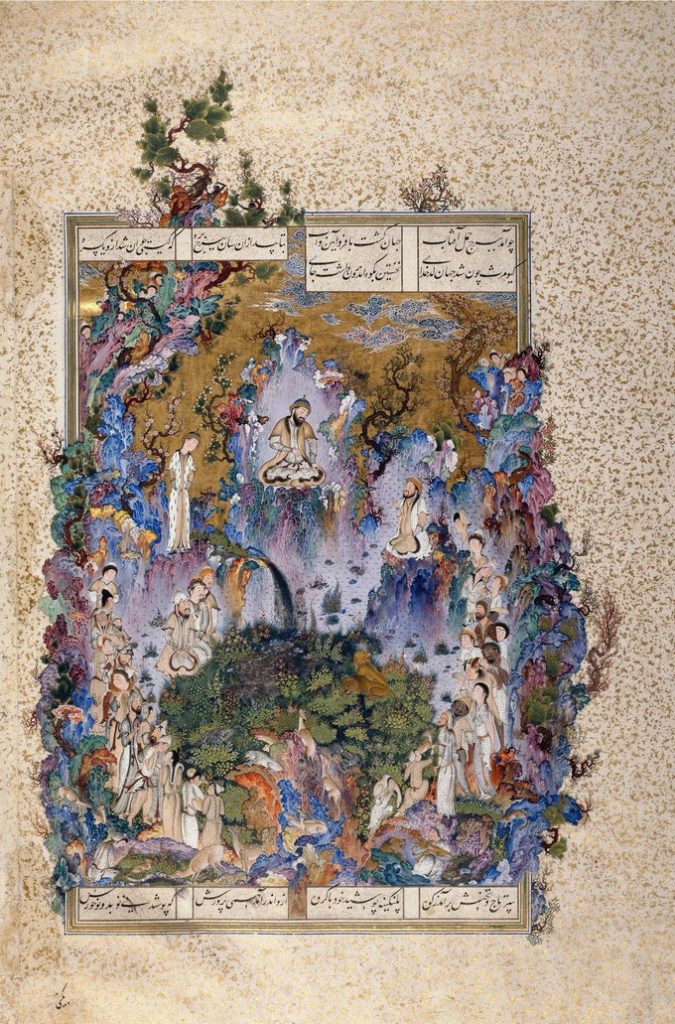
Islamic Ceramics
Islamic art has notable achievements in ceramics that reached heights unmatched by other cultures.
Learning Objectives
- Discuss how developments such as opaque glazes and stonepaste ceramics made Islamic ceramics some of the most advanced of its time.
Key Points
- The first Islamic opaque glazes date to around the 8th century, and another significant contribution was the development of stonepaste ceramics in 9th century Iraq.
- Lusterwares with iridescent colors were either invented or considerably developed in Persia and Syria from the 9th century onward.
- The techniques, shapes, and decorative motifs of Chinese ceramics were admired and emulated by Islamic potters, especially after the Mongol and Timurid invasions.
Key Terms
- lusterware: A type of pottery or porcelain having an iridescent metallic glaze.
- glaze: The vitreous coating of pottery or porcelain, or a transparent or semi- transparent layer of paint.
- ceramics: Inorganic, nonmetallic solids created by the action of heat and their subsequent cooling. Most common ceramics are crystalline and the earliest uses of ceramics were in pottery.
Islamic Ceramics
Islamic art has notable achievements in ceramics, both in pottery and tiles for buildings, which reached heights unmatched by other cultures. Early pottery had usually been unglazed, but a tin-opacified glazing technique was developed by Islamic potters. The first Islamic opaque glazes can be found as blue-painted ware in Basra, dating to around the 8th century.
Another significant contribution was the development of stonepaste ceramics, originating from 9th century Iraq. The first industrial complex for glass and pottery production was built in Ar-Raqqah, Syria, in the 8th century.
Lusterware
Lusterware is a type of pottery or porcelain that has an iridescent metallic glaze. Luster first began as a painting technique in glassmaking, which was then translated to pottery in Mesopotamia in the 9th century.
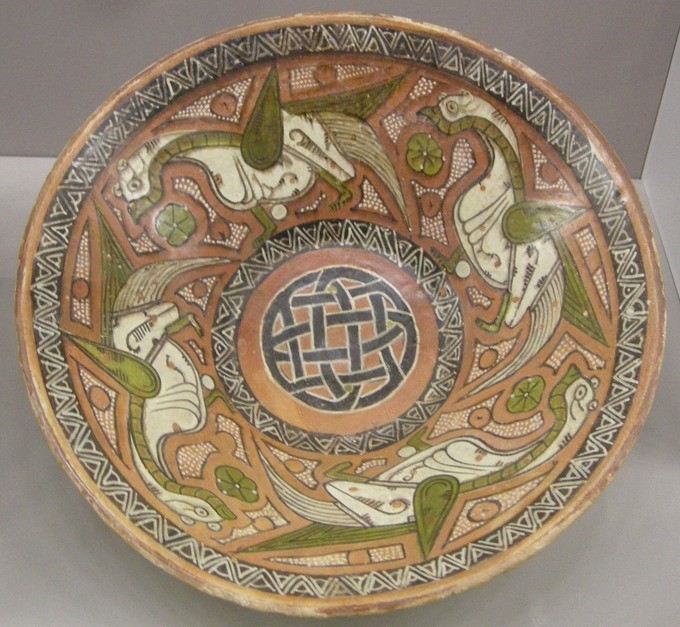
The techniques, shapes, and decorative motifs of Chinese ceramics were admired and emulated by Islamic potters, especially after the Mongol and Timurid invasions. Until the Early Modern period, Western ceramics had little influence, but Islamic pottery was highly sought after in Europe, and was often copied.
Islamic Textiles
The most important textile produced in the Medieval and Early Modern Islamic Empires was the carpet.
Learning Objectives
- Discuss the making and designs of Islamic textiles.
Key Points
- The production and trade of textiles pre-dates Islam, and had long been important to Middle Eastern cultures and cities, many of which flourished due to the Silk Road.
- When the Islamic dynasties formed and grew more powerful they gained control over textile production in the region, which was arguably the most important craft of the era.
Key Terms
- textile arts: The production of arts and crafts that use plant, animal, or synthetic fibers to create objects.
Islam and the Textile Arts
The textile arts refer to the production of arts and crafts that use plant, animal, or synthetic fibers to create objects. These objects can be for everyday use, or they can be decorative and luxury items. The production and trade of textiles pre-dates Islam, and had long been important to Middle Eastern cultures and cities, many of which flourished due to the Silk Road.
When the Islamic dynasties formed and grew more powerful they gained control over textile production in the region, which was arguably the most important craft of the era. The most important textile produced in Medieval and Early Modern Islamic Empires was the carpet.
The Ottoman Empire and Carpet Production
The art of carpet weaving was particularly important in the Ottoman Empire. The Ottoman state was founded by Turkish tribes in northwestern Anatolia in 1299 and became an empire in 1453 after the momentous conquest of Constantinople.
Stretching across Asia, Europe, and Africa, the Empire was vast and long lived, lasting until 1922 when the monarchy was abolished in Turkey. Within the Ottoman Empire, carpets were immensely valued as decorative furnishings and for their practical value. They were used not just on floors but also as wall and door hangings, where they provided additional insulation.
These intricately knotted carpets were made of silk, or a combination of silk and cotton, and were often rich in religious and other symbolism. Hereke silk carpets, which were made in the coastal town of Hereke, were the most valued of the Ottoman carpets because of their fine weave. The Hereke carpets were typically used to furnish royal palaces.
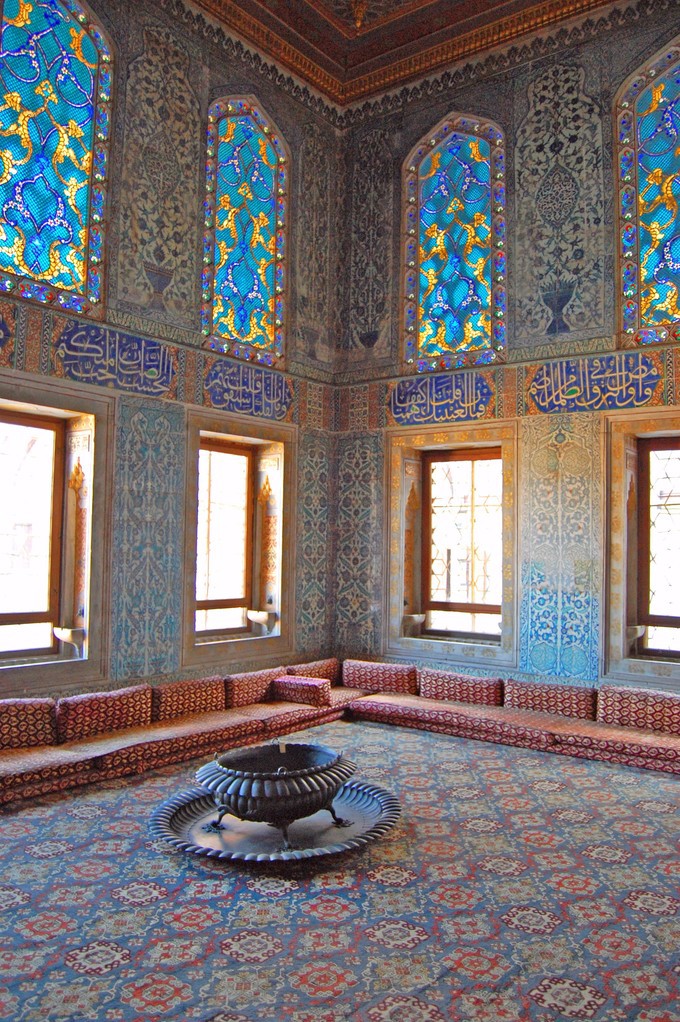
Persian Carpets
The Iranian Safavid Empire (1501–1786) is distinguished from the Mughal and Ottoman dynasties by the Shia faith of its shahs, which was the majority Islamic denomination in Persia. Safavid art is contributed to several aesthetic traditions, particularly to the textile arts.
In the sixteenth century, carpet weaving evolved from a nomadic and peasant craft to a well-executed industry that used specialized design and manufacturing techniques on quality fibers such as silk. The carpets of Ardabil, for example, were commissioned to commemorate the Safavid dynasty and are now considered to be the best examples of classical Persian weaving, particularly for their use of graphical perspective.
Textiles became a large export, and Persian weaving became one of the most popular imported goods of Europe. Islamic carpets were a luxury item in Europe and there are several examples of European Renaissance paintings that document the presence of Islamic textiles in European homes during that time.

- 1 https://en.wikipedia.org/wiki/Abd_al-Rahman_I ↵

